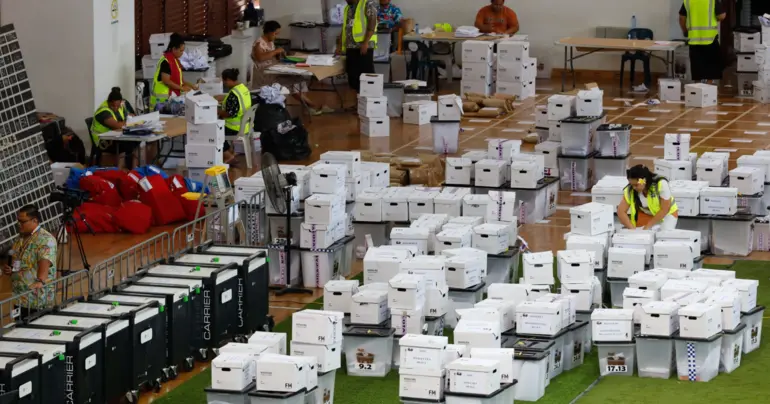No clinical evidence of success against obesity: academic
 By Fuimaono Lumepa Hald
•
11 April 2022, 11:03PM
By Fuimaono Lumepa Hald
•
11 April 2022, 11:03PM
A senior doctor and academic has questioned the Ministry of Health’s strategies to reduce obesity and obesity-related diseases, saying there is “no clinical evidence” of its success over the years.
In a medical journal article titled “Does Samoa have adequate policies to reduce obesity and obesity-related disease?” published 16 March 2022 and authored by Toleafoa Dr Viali Lameko, the Oceania University of Medicine (O.U.M.) academic quoted a number of studies which he said confirmed the prevalence of obesity in Samoa and other Pacific island nations and territories.
One study Toleafoa referenced in his paper was done in 2017 and is titled: “Trends in diabetes and obesity in Samoa over 35 years, 1978–2013”. He quoted the study forecasting that obesity prevalence in Samoa would reach 59.0 per cent among Samoan men and 81.0 per cent among women in 2020, to make it the “leading cause of disability” in Samoa.
Samoans’ shift away from traditional diet and lifestyles was also highlighted by Toleafoa, who pointed to a February 2012 study titled “Long-term trends in food availability, food prices and obesity in Samoa”. In that study the shift by Samoans from their traditional diet of vegetable root and tree crops with seafood and birds to processed food was highlighted.
“In that period, the traditional Samoan diet of staple vegetable root and tree crops, coconut, fish and other seafood, native birds, and more rarely, pork and chicken have largely been replaced by imported processed foods such as canned and brined beef, canned fish, mutton flaps, factory-farmed chicken, turkey tails, heavily sweetened beverages, bread and other flour-baked goods, and rice, to name a few.”
Toleafoa said the Samoa Government, like other governments in the region, acknowledged the cost of non-communicable diseases and obesity and formulated a number of health policies to intervene at the national level.
However, diets in Samoa are not the only things that have changed according to the O.U.M. academic, who then pointed to the health delivery systems and said it too has shifted from being community-based to hospital-based.
A 2019 study titled “Town as a village: urbanisation, governance and neo-traditionalism in Samoa” encapsulated the challenges between the 1970s and 1980s – when the village women committees that played pivotal roles in disease prevention at the community level – were pushed to the periphery with the people going to the health centres and district hospitals for treatment.
Samoa then moved to community-based interventions and brought in school programs to promote physical education and after-school sports together with collaborations with village women committees to support screening of non-communicable disease.
And while Samoa’s policy advocated a multi-sector approach to reduce NCDs, Toleafoa said the Government nor the Ministry did not offer details on how “structural challenges” could be overcome in their bid to tackle NCDs and quoted a 2014 study titled "Trade and health in Samoa: views from the insiders" to emphasise his point.
“In addition, the recent health-sponsored television commercials do not mention the importance of reducing the consumption of sugar in their diet but focus only on performing physical exercise and eating vegetables,” reads the 2014 study. “Shown on prime time TV, they are often followed by advertisements for sweet drinks and other sugary products by local manufacturers and retailers.
“Given the evident historical failure of behaviour change approaches, there are questions to be asked about the degree to which behaviour and personal choices are contributing factors to the development of overweight and obesity in Samoa and the rest of the world today.”
Toleafoa wrote that "obesity is a political as well as a policy issue" and if the Samoa Government wanted to reduce the incidences of NCDs, then it has to take "a more active multi-sectoral approach".
"If the Government of Samoa is to offset the rising cost of treating NCDs, it will have to adopt a more active multi-sectoral approach which could include laws, taxes, tariffs, and subsidies to increase consumption of fresh local food and decrease consumption of imported food.
"But such measures will be politically unpopular, especially with local importers, wholesalers, retailers, and manufacturers.
"Unless carefully applied, such measures may make food too expensive for public consumption. Local manufacturers produce beer, soft drinks, ice cream, and various snack foods made from ingredients imported via global supply chains. Local merchants import hundreds of similar inexpensive products."
Tags
 By Fuimaono Lumepa Hald
•
11 April 2022, 11:03PM
By Fuimaono Lumepa Hald
•
11 April 2022, 11:03PM











